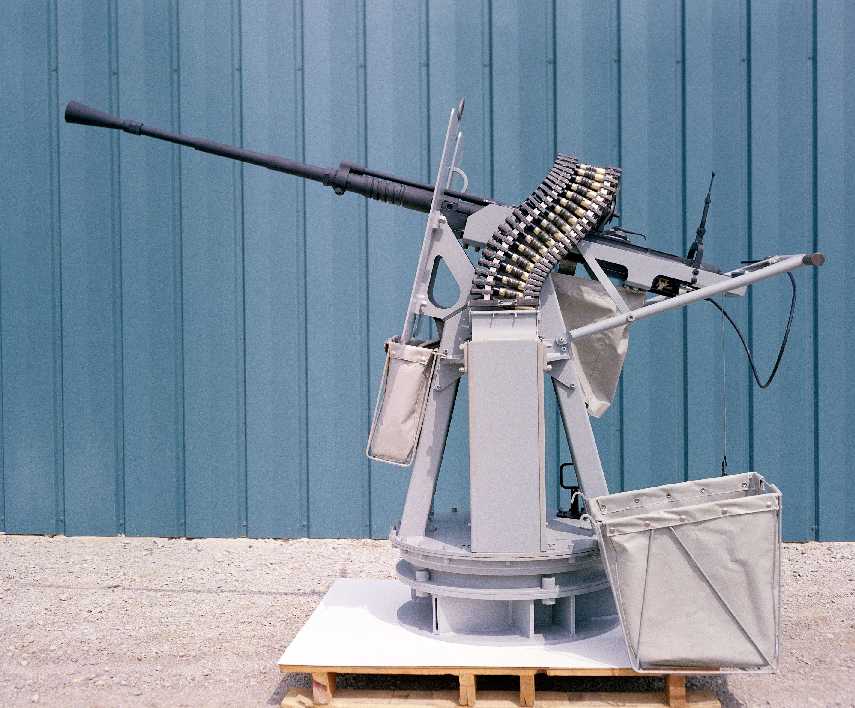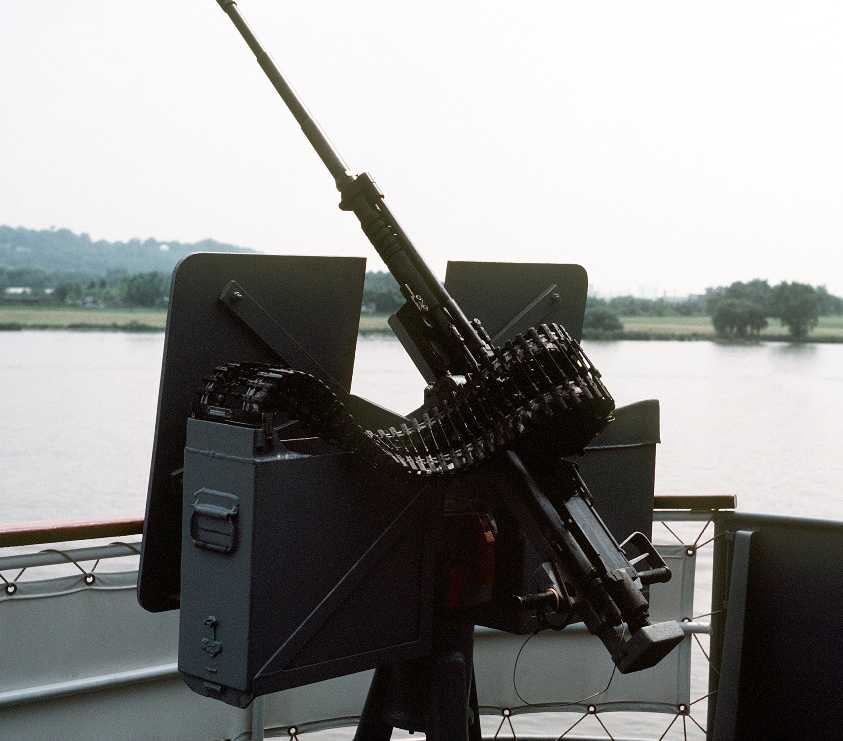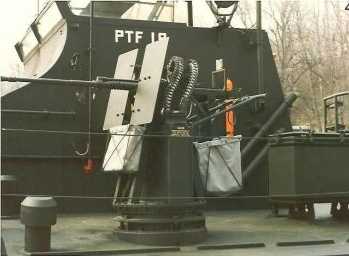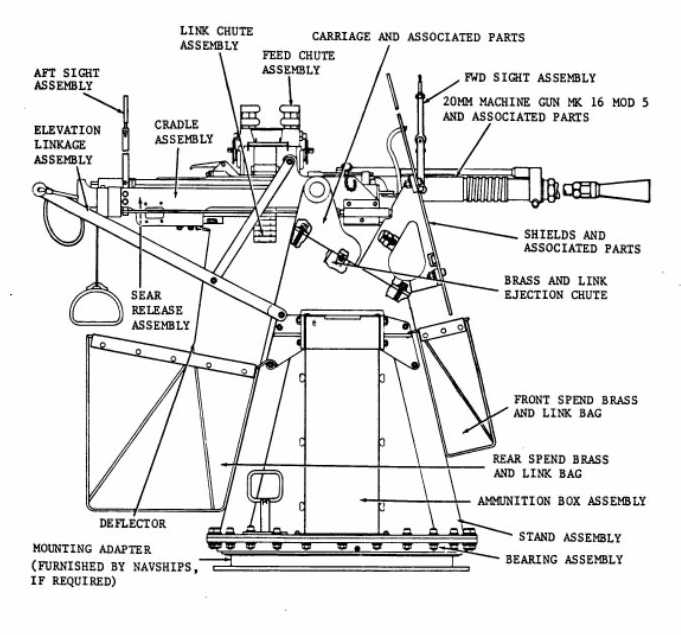
These were the AN/M3 and M24 aircraft guns converted for use as small-craft surface weapons. The AN/M3 was a derivative of the Swiss Hispano-Suiza HS404 cannon, which was introduced in the late 1930s. These guns were not widely used on US aircraft until after World War II when the improved AN/M3 version was developed. This version was then used to arm many fighters and bombers during the 1950s. The AN/M3 gun used lubricated, percussion-primed ammunition. The M24 aircraft gun was a further modification that fired electric-primed ammunition, which the Air Force considered to be more reliable than percussion ammunition. All of these guns operated with an open breech and had a gas-assisted, blowback operation, with the recoil motion being used to feed the next round of ammunition.
During the Vietnam War, the Navy acquired a fleet of small craft which were used to patrol the coastal waters and rivers of Vietnam. These boats had a need for larger automatic weapons than the 0.50" (12.7 mm) BMG. By the 1960s, the number of Oerlikons available was limited and spares were becoming difficult to find, so the Navy decided to adapt AN/M3 aircraft guns for shipboard use. These modified guns were then designated as Mark 16. Unlike the Oerlikon, the Mark 16 was belt-fed and fired a larger and more powerful round. There were two principal versions of the Mark 16 in service: Mod 4, which has an electrical trigger mechanism, and the Mod 5, which has a hand-operated stepped mechanical trigger.
Ammunition was linked and fed through a feed chute to the delinking feeder on top of the gun. Lubrication for the ammunition was provided by a pump that put a drop of semi-fluid lubricating oil (LSA) in the chamber each time the gun fired.
About 5,000 Mark 16 guns were delivered during the Vietnam War. In 1982 those guns and mountings still remaining in naval service were described as being unreliable and difficult to maintain and were subsequentially phased out in favor of the 25 mm chain gun. However, many Air Force M24 guns were cannibalized during the 1980s and 1990s to provide spare parts for the US Coast Guard which had continued to use the Mark 16.
Unless otherwise noted, the data that follows is for the Mark 16 Mod 5.
| Designation | 20 mm Mark 16 |
|---|---|
| Ship Class Used On | Patrol Craft of the Vietnam War, some larger warships
Coast Guard Cutters |
| Date Of Design | about 1975 (navalized version) |
| Date In Service | 1976 |
| Gun Weight | 116 lbs. (52.6 kg) |
| Gun Length oa | 77.7 in (1.974 m) |
| Bore Length | N/A |
| Rifling Length | N/A |
| Grooves | N/A |
| Twist | N/A |
| Chamber Volume | N/A |
| Rate Of Fire | Cyclic: 600 - 850 rounds per minute |
- USS Tarawa LHA-1 was the first ship to carry the Mark 16.
- The aircraft version of the M3 weighed 99.5 lbs. (45 kg) and had a cyclic rate of up to 800 rounds per minute.
| Type | Fixed |
|---|---|
| Weight of Complete Round | N/A |
| Projectile Types and Weights | M90 Series
M95 APT: 130 gm M96 INC: 102 gm M97 HEI: 130 gm |
| Bursting Charge | N/A |
| Projectile Length | N/A
Complete Round - 7.24 in (18.4 cm) |
| Propellant Charge | N/A |
| Cartridge | 20 x 110 mm (rimless type) |
| Muzzle Velocity | HE Percussion: 2,680 fps (817 mps)
HE Electric: 3,100 fps (945 mps) |
| Working Pressure | N/A |
| Approximate Barrel Life | N/A |
| Ammunition stowage per gun | See Mounting Notes |
Projectiles for these guns are very similar to those for the Oerlikon 20 mm guns of World War II fame. They differ by having a smaller explosive cavity at the rear of the projectile. This makes for a thicker wall around the base which better resists the crushing action created by the driving band as the projectile travels down the gun barrel.
| Designation
(see Note 1) |
Single Mounts
Mark 67 and Mark 68 |
|---|---|
| Weight | Mark 67: 475 lbs.
Mark 68: 775 lbs. |
| Elevation | Mark 67: -30 / +75 degrees
Mark 68: -45 / +70 degrees |
| Elevation Rate | Manual Elevation, only |
| Train | 360 degrees |
| Train Rate | Manual Training, only |
| Gun recoil | N/A |
- The Mark 67 used a single ammunition box containing 385 linked rounds. The Mark 68 had two 200 round boxes, which allowed the gunner to switch between two different kinds of ammunition by switching belts.
- The Mark 68 was considered an interim design until the Mark 67 could enter series production.





"US Naval Weapons" and "The Naval Institute Guide to World Naval Weapon Systems 1991/92" both by Norman Friedman
"Jane's Ammunition Handbook: Ninth Edition 2000-2001" edited by Terry J. Gander and Charles Q. Cutshaw
"Rapid Fire" by Anthony G. Williams
---
"Gunners Mate Training Manual" NAVEDTRA 14110
"Naval Ordnance and Gunnery - 1952" Navpers 16116-B
---
NAVORD 3990 as shown on-line at Warboats
Special help from Robert Stoner of Warboats
19 November 2008 - Benchmark
28 August 2012 - Added ammunition information
08 August 2016 - Converted to HTML 5 format
